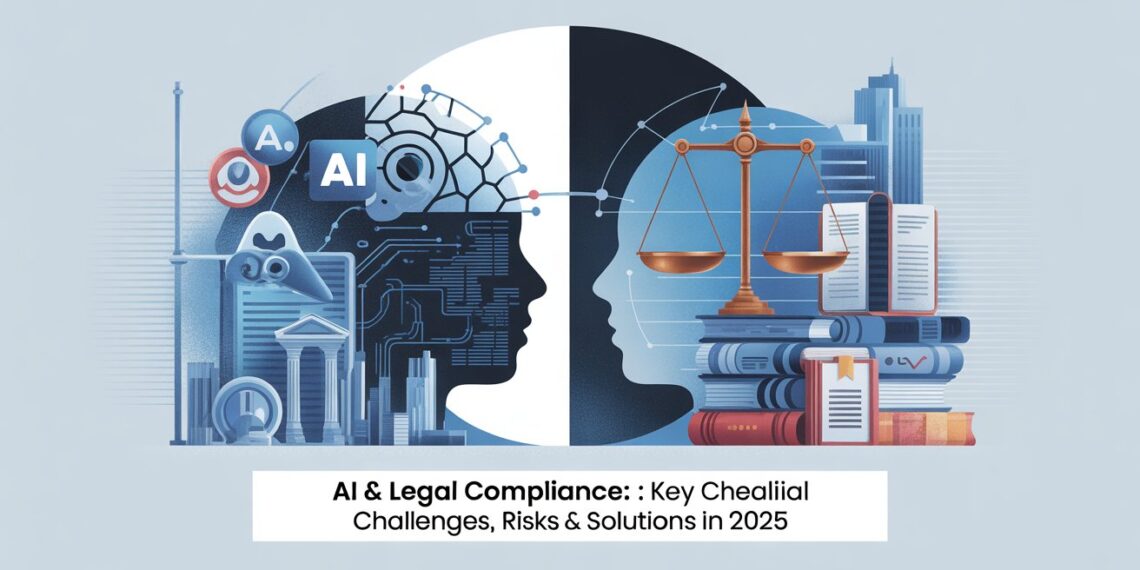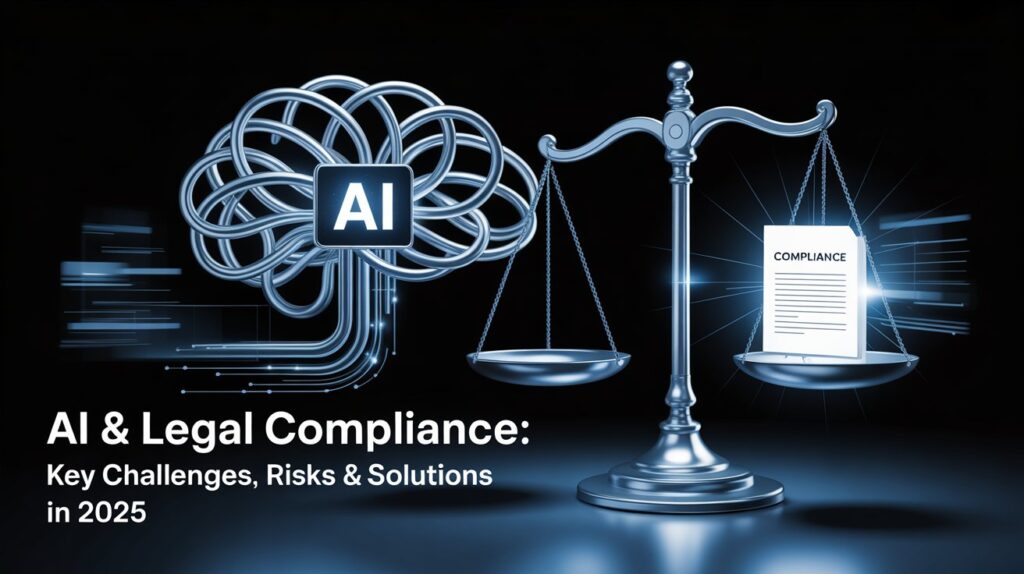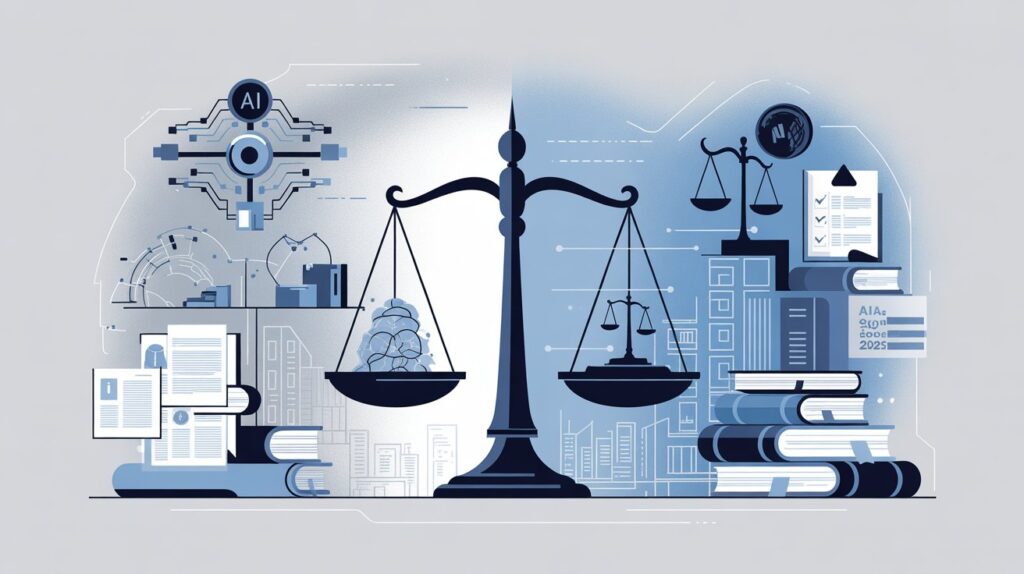Artificial intelligence (AI) is rapidly transforming industries across the globe, and the legal and compliance sectors are at the forefront of this evolution. From automating contract review and regulatory reporting to enhancing fraud detection and risk management, AI offers significant efficiency and accuracy gains. However, with such rapid adoption comes new and complex challenges. Questions around accountability, regulatory compliance, ethical boundaries, and operational transparency are becoming central concerns for businesses, governments, and legal professionals alike.
The legal sector, known for its cautious and rule-driven nature, must now reconcile innovation with strict regulatory requirements. Compliance teams, already burdened with complex frameworks, must adapt to the unique demands of AI systems that learn, evolve, and occasionally produce unpredictable results. This article provides an in-depth exploration of AI & Legal Compliance: Key Challenges, highlighting risks, analyzing global regulatory approaches, offering real-world examples, and presenting practical strategies for organizations to adopt AI responsibly.
Understanding the AI Compliance Landscape
Unlike traditional technologies, AI presents distinct challenges due to its ability to learn from data and change over time. Compliance is not a one-time exercise but a continuous process involving oversight, monitoring, and adaptation. Organizations need to ensure that AI-driven decisions meet legal requirements, ethical expectations, and industry best practices.
Why Compliance in AI Is Different
- Dynamic Learning: Traditional compliance focuses on static systems. AI evolves, requiring ongoing audits.
- Opacity of Models: Many algorithms, particularly deep learning, act as black boxes, complicating transparency.
- Scale of Impact: AI often operates across multiple business functions and jurisdictions, magnifying regulatory complexity.
Global Regulatory Trends
- European Union (EU): The EU AI Act introduces risk-based classifications of AI systems. High-risk applications, such as healthcare or law enforcement AI, must meet strict requirements for transparency, human oversight, and accountability. Non-compliance can result in multi-million-euro fines.
- United States: The U.S. lacks a single unified AI law but relies on existing frameworks like consumer protection, anti-discrimination, and privacy laws. Agencies such as the FTC and SEC are becoming more active in addressing AI misuse.
- Asia-Pacific: Singapore, Japan, and South Korea emphasize AI ethics, publishing guidelines that balance innovation with accountability.
- Emerging Economies: Developing markets are in the early stages of drafting AI policies. Enforcement mechanisms may lag, but global pressure ensures they will eventually align with international standards.
Key Challenges in AI & Legal Compliance
1. Transparency and Explainability
AI models often deliver outputs without clear reasoning. Legal teams face challenges when regulators or courts demand explanations for automated decisions.
- Risk: Black-box systems undermine trust and hinder regulatory compliance, particularly under frameworks like the EU AI Act.
- Solution: Use explainable AI (XAI) tools, document decision-making processes, and maintain comprehensive audit trails.
2. Bias, Fairness, and Discrimination
AI can inadvertently reinforce social inequalities due to biased training data.
- Risk: Biased algorithms may violate anti-discrimination laws, leading to reputational damage and litigation.
- Solution: Conduct bias audits, integrate fairness metrics, and implement human-in-the-loop review mechanisms.
3. Data Privacy and Security
AI depends heavily on sensitive personal data.
- Risk: Data misuse or breaches could violate GDPR, HIPAA, or local data protection laws.
- Solution: Apply privacy-by-design principles, anonymize data where possible, and enforce robust cybersecurity protections.
4. Accountability and Liability
Determining who is legally responsible when AI fails remains unresolved.
- Risk: Organizations face unclear liability for financial loss, fraud, or misinformation caused by AI.
- Solution: Define liability through contracts, require vendor warranties, and establish human accountability checkpoints.
5. Intellectual Property Concerns
Generative AI creates outputs that may inadvertently infringe copyright.
- Risk: Copyright claims or disputes over AI-generated works.
- Solution: Track data provenance, document content generation, and implement internal IP compliance policies.
6. Integration with Legacy Systems
Legacy IT environments often struggle to integrate AI effectively.
- Risk: Poor integration can disrupt compliance workflows or create security vulnerabilities.
- Solution: Use modular designs, implement data governance frameworks, and roll out integration gradually.
7. Regulatory Uncertainty
AI law is evolving quickly and inconsistently.
- Risk: Compliance strategies in one jurisdiction may fail elsewhere.
- Solution: Monitor regulatory developments, adopt adaptive compliance practices, and consult cross-border legal expertise.
8. Cross-Functional Governance
AI adoption requires collaboration beyond IT teams.
- Risk: Misaligned priorities across legal, compliance, and data science teams hinder compliance efforts.
- Solution: Establish AI governance committees and mandate regular inter-departmental communication.
9. Ethical Concerns and Trust
Public trust is critical for sustainable AI adoption.
- Risk: Misuse or unethical deployment of AI damages organizational reputation.
- Solution: Engage stakeholders in decision-making, prioritize transparency, and ensure human oversight.
10. AI Washing and Misrepresentation
Companies may exaggerate their AI capabilities to attract investors or customers.
- Risk: Misrepresentation can lead to regulatory penalties and loss of credibility.
- Solution: Ensure accurate disclosures and audit claims about AI systems.
Building a Framework for AI Compliance
A systematic compliance framework can help organizations navigate legal complexities.
- Governance & Oversight: Define responsibilities and establish oversight committees.
- Risk Classification: Categorize AI systems into high, medium, and low risk.
- Documentation: Maintain records of design, testing, and deployment.
- Data Management: Enforce strict privacy, security, and quality controls.
- Monitoring & Auditing: Implement continuous oversight with regular third-party reviews.
- Vendor Due Diligence: Hold vendors accountable for compliance standards.
- Incident Response: Develop clear escalation protocols for AI failures.
- Employee Training: Educate teams on ethical and legal implications.
Comparative Jurisdictional Analysis
European Union
The EU AI Act will likely become the global benchmark for AI regulation. Companies operating internationally must prepare for compliance even if not headquartered in the EU.
United States
U.S. regulation is decentralized but increasingly strict in high-risk sectors such as finance, healthcare, and employment.
Asia-Pacific
Countries emphasize balancing innovation with responsibility. Singapore’s Model AI Governance Framework has been widely cited as a best-practice guide.
Emerging Economies
Nations like India and Brazil are drafting policies to align with global standards, though enforcement may remain inconsistent.
Case Studies
Case 1: Financial Services
A global bank used AI in credit scoring but faced allegations of racial bias. The bank responded by retraining models on more diverse datasets and implementing bias audits. These changes improved both compliance and customer trust.
Case 2: Healthcare
A hospital’s AI-powered diagnostic tool violated GDPR due to insufficient consent management. The hospital revised its data practices, adopted anonymization, and implemented real-time consent monitoring.
Case 3: Law Firms
Law firms using generative AI for drafting contracts risked copyright violations. They mitigated these risks by using proprietary data, auditing vendor compliance, and setting internal usage policies.
Case 4: E-commerce
An online retailer faced regulatory scrutiny for AI-driven pricing algorithms that were accused of price discrimination. By increasing transparency and adopting explainability frameworks, the retailer reduced regulatory exposure.
Future Trends in AI Legal Compliance
- Generative AI Regulation: Expect stronger oversight of AI-generated content and IP issues.
- Cross-Border Harmonization: Global efforts toward unified AI standards.
- AI Liability Laws: Clearer frameworks for assigning responsibility.
- Certification Systems: Independent certifications for compliant AI systems.
- Judicial Use of AI: Courts experimenting with AI for case analysis will require careful legal safeguards.
- Adaptive Regulation: Regulators adopting “sandbox” models to test AI under controlled conditions.
FAQs on AI & Legal Compliance: Key Challenges
1. What are the main legal risks of using AI?
The primary risks include data privacy violations, algorithmic bias, unclear liability, intellectual property infringement, and regulatory non-compliance.
2. How can organizations ensure compliance in AI systems?
Organizations can ensure compliance by embedding legal checks at each stage of development, conducting regular audits, using explainability techniques, and monitoring regulatory updates.
3. What role does human oversight play in AI compliance?
Human oversight provides accountability, reduces blind reliance on AI, and strengthens the organization’s legal defensibility.
4. Which regulations affect AI compliance most?
The EU AI Act, GDPR, HIPAA, and national data protection and consumer protection laws are the most significant.
5. How can companies manage compliance across jurisdictions?
They can do this by monitoring global regulatory updates, engaging local legal experts, and adopting adaptive frameworks that work across borders.
6. Can AI compliance frameworks also address ethical concerns?
Yes, ethical frameworks go beyond legal requirements, addressing fairness, accountability, and societal trust in AI systems.
7. What industries face the highest AI compliance risks?
Financial services, healthcare, government, and employment-related industries face the strictest scrutiny and penalties.
Conclusion
AI has become an indispensable part of modern compliance and legal practice. However, its use introduces complex challenges that demand careful oversight, structured governance, and proactive monitoring. Addressing AI & Legal Compliance: Key Challenges requires organizations to integrate legal, technical, and ethical safeguards at every stage of AI adoption.
Those who balance innovation with compliance will not only minimize risks but also build stronger trust, improve transparency, and secure long-term resilience. In a fast-evolving regulatory landscape, treating compliance as a foundation—not an obstacle—will determine which organizations thrive in the AI-driven future.












